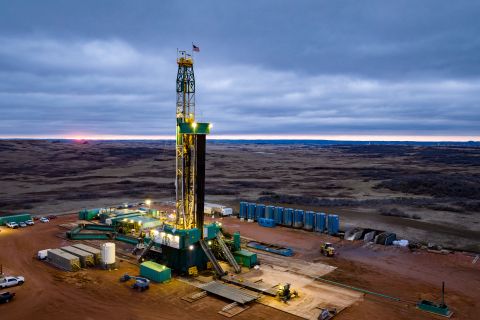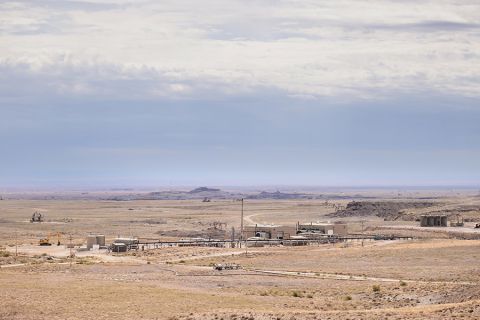Deepwater drillers in the Gulf of Mexico have to contend with many issues-rig availability, lease expirations, opaque subsalt seismic images, and stunning inflation in service costs. If those challenges aren't enough, Mother Nature also throws in such twists as hurricanes and loop currents to bedevil operators. "Loop currents have affected us more than we would have thought possible a couple of years ago," says Darrell Hollek, vice president, southern region and Gulf of Mexico, for Oklahoma City-based Kerr-McGee Corp. "And more recently, hurricanes have been a problem." Loop currents have been known for many years, but their impact has been felt more acutely as drilling operations have moved into ultradeep waters. "We're finding that there are certain times of the year that we can't drill or install facilities when the loops are too strong," he says. The loops drive circulation in the Gulf of Mexico, carrying warm waters from the Caribbean Sea past the Yucatan and into the deep waters of the east-central Gulf. The currents swoop around Cuba and exit though the Florida Straits, then join the Gulf Stream. They move at rapid clips, and cause problems with rig positions and riser placements and retrievals. The swirling waters also add to materials fatigue on deepwater equipment. "When loop currents are active, there are periods of time when operators cannot drill effectively, even in shallower water depths of 5,000 to 6,000 feet," says Waqar Syed, Denver-based analyst with Petrie Parkman & Co. "They are quite a headache." Mainly, loop currents tend to run in the eastern portion of the Gulf, but their positions vary widely from year to year and season to season. During 2005, operators also learned to their dismay that hurricanes can greatly accelerate loop currents. And, although the loops are usually calm in the spring, this year operators are already fighting strong currents. Rigs drilling in the central and western Gulf are hardly home-free, however. A disconcerting characteristic of loop currents is their tendency to form eddies that detach and spin westward. The upshot? Operators are losing more and more rig days to the loops, and the industry is frantically trying to figure out how to overcome these problems. Hurricanes pose even more challenges. According to the U.S. Minerals Management Service, daily volumes of 340,000 barrels of oil and 1.3 billion cubic feet (Bcf) of gas remain shut in due to hurricane damage in the Gulf of Mexico. At this depressed level, the Gulf now produces 1.5 million barrels of oil and 10 Bcf of gas each day. Lost production is not the only problem: "During the last hurricane season, the moorings on a number of deepwater rigs failed and some were found 150 miles from where they had been working," says Syed. Mooring systems have to be improved, or conventionally moored rigs in the Gulf will have to be replaced by dynamically positioned rigs and drillships, he says. Drilling contractor Transocean Inc., for instance, has two deepwater rigs affected by last year's storms. The company is upgrading the mooring systems on those units from eight anchors to 12 anchors, at a cost of $8- to $12 million for each rig, excluding out-of-service time. Even if rigs and facilities are undamaged in a hurricane, the industry's steady move into ultradeep waters only increases the complexities of storm preparations. The expenses to secure wells, pull very long lengths of risers, and move rigs out of the paths of storms are commanding greater shares of total project costs. In a recent paper scheduled for presentation at the 2006 Offshore Technology Conference in Houston, BP reports that the number of times a riser is pulled in anticipation of a hurricane can be three times the frequency of hurricanes at the location. "The cumulative effect of all the environmental downtime can significantly extend the duration, and therefore increase the cost, of a drilling program," the company reports. The development of new riser technology is one approach to a solution. BP worked with simulations on development of its Atlantis project that considered conventional risers against risers that could be detached near the top and left freestanding in the water column, and also against freestanding risers with drag-reduction technology added.
Recommended Reading
E&P Highlights: Nov. 4, 2024
2024-11-05 - Here’s a roundup of the latest E&P headlines, including a major development in Brazil coming online and a large contract in Saudi Arabia.
Smart Tech Moves to the Hazardous Frontlines of Drilling
2024-10-08 - In the quest for efficiency and safety, companies such as Caterpillar are harnessing smart technology on drilling rigs to create a suite of technology that can interface old and new equipment.
EY: How AI Can Transform Subsurface Operations
2024-10-10 - The inherent complexity of subsurface data and the need to make swift decisions demands a tailored approach.
Now, the Uinta: Drillers are Taking Utah’s Oily Stacked Pay Horizontal, at Last
2024-10-04 - Recently unconstrained by new rail capacity, operators are now putting laterals into the oily, western side of this long-producing basin that comes with little associated gas and little water, making it compete with the Permian Basin.
E&P Highlights: Oct. 28, 2024
2024-10-28 - Here’s a roundup of the latest E&P headlines, including a new field coming onstream and an oilfield service provider unveiling new technology.
Comments
Add new comment
This conversation is moderated according to Hart Energy community rules. Please read the rules before joining the discussion. If you’re experiencing any technical problems, please contact our customer care team.





